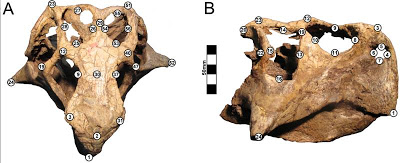
A new analysis of dinosaur fossils by University of Pennsylvania researchers has revealed that a number of specimens of the genus Psittacosaurus — once believed to represent three different species — are all members of a single species. The differences among the fossil remains that led other scientists to label them as separate species in fact arose from how the animals were buried and compressed, the study found.
“Because of the vagaries of fossilization, no two fossils are the same,” said senior author Peter Dodson, professor of anatomy in Penn’s School of Veterinary Medicine and professor of paleontology in the School of Arts and Sciences’ Department of Earth and Environmental Science. “Animals are alive and they die, but what’s crucial in paleontology is what happens to the animals after they die.”
The research involved a cutting-edge technique, known as three-dimensional geometric morphometrics, which uses lasers to generate data about the shape of different specimens. This is the first time the approach has been used to study dinosaur fossils and could lead to a re-examination of the taxonomic classifications of additional dinosaur species as well as other long-extinct fossil organisms.
Brandon Hedrick, a doctoral student in the Department of Earth and Environmental Science, led the study in collaboration with Dodson. Their research will be reported in the journal PLOS ONE.
The investigation focused on dinosaurs in the genus Psittacosaurus, a word that comes from the Greek for “parrot lizard.” The group was named for the animal’s beaked face, not unlike that of a turtle. Originally discovered in 1923, 15 species have been classified as Psittacosaurus, though a recent analysis confirmed only nine of these as definite members of the genus. These animals were small plant-eaters that lived 120 to 125 million years ago. Paleontologists have discovered Psittacosaurus fossils in Mongolia, China and Russia and possibly in Thailand.
“Meat-eaters are sexy; plant-eaters are not,” Dodson said. “This isn’t a flashy dinosaur. But it has an interesting feature in that it’s one of the most abundant dinosaurs known to science.”
Indeed, many hundreds of Psittacosaurus specimens have been found. This abundance made the genus ideal for Hedrick and Dodson’s comparative study, as it is easier to determine relationships within and between species when there are more individuals to compare.
“For example, if you have a single dachshund and a single beagle, they may appear to be different species until you found 40 dachshund-beagle mixes of various grades to examine,” Hedrick said.
The scientists examined Psittacosaurus skulls discovered in the fossilized ashes of the Lujiatun beds of northeastern China’s Yixian Formation. Paleontologists had previously identified the skulls as belonging to three different species, Psittacosaurus lujiatunensis, P. major or Hongshanosaurus houi.
To compare and contrast the specimens, the researchers used two techniques. First they conducted a traditional study in which they examined every skull that had been classified as one of those three species — a total of 74 specimens — for a variety of characteristics that had been used in prior studies to distinguish the species. The Penn team also compared these fossils to skulls that had been classified as belonging to eight other Psittacosaurus species.
Next they completed a more high-tech analysis of 30 skulls from the three named species. Using a hand-held stylus that captures a point in space relative to a transmitter, they pinpointed 56 “landmarks,” or particular anatomical locations, on each fossil and compared the relative position of those marks between specimens. They also used a hand-held, laser-emitting scanner to make a three-dimensional image of each specimen, similar to a CT scan, from which they also collected landmark data.
Based on the “old-fashioned” method of examining the physical skulls, the researchers concluded that the three purported species were in fact one. They propose that all three can be considered members of the species P. lujiatunensis.
Results from the geometric morphometric analysis, though not sufficient on its own to classify species, supported this conclusion and suggested that how an animal’s body was crushed as it fossilized — from the top, from the side or twisted — could lead to inaccurate species determinations.
“Our study found all of these false ‘species’ that are not biological species but are apparent species caused by the process of fossilization,” Dodson said.
The Penn team said their investigation shows the value of traditional taxonomic analysis, while also revealing the potential of a new approach to analyzing fossils.
“Hopefully this will open up the paleontological community to using three-dimensional geometrics morphometrics in a variety of ways,” Hedrick said. “This technique has limitless applications to understanding dinosaurs.”
Note : The above story is based on materials provided by University of Pennsylvania, via EurekAlert!, a service of AAAS.










